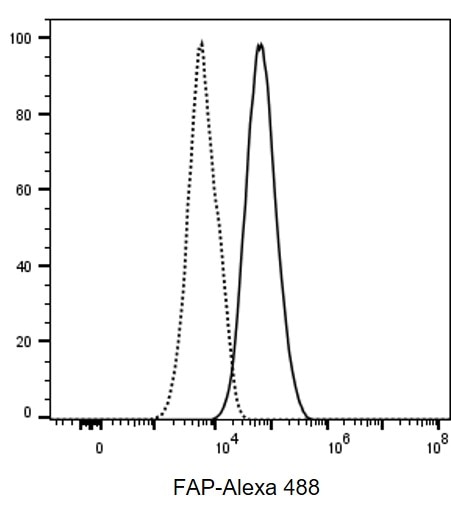Human Fibroblast Activation Protein alpha /FAP Alexa Fluor® 488-conjugated Antibody
Human Fibroblast Activation Protein alpha /FAP Alexa Fluor® 488-conjugated Antibody Summary
Leu26-Asp760
Accession # Q12884
Applications
Please Note: Optimal dilutions should be determined by each laboratory for each application. General Protocols are available in the Technical Information section on our website.
Scientific Data
 View Larger
View Larger
Detection of Fibroblast Activation Protein alpha /FAP in WI‑38 Human Cell Line by Flow Cytometry. WI-38 human lung fibroblast cell line was stained with Mouse Anti-Human Fibroblast Activation Protein a/FAP Alexa Fluor® 488-conjugated Monoclonal Antibody (Catalog # FAB3715G, filled histogram) or isotype control antibody (IC002G, open histogram). View our protocol for Staining Membrane-associated Proteins.
 View Larger
View Larger
Detection of Fibroblast Activation Protein alpha /FAP in U‑87 MG cells by Flow Cytometry. U‑87 MG cells were stained with Mouse Anti-Human Fibroblast Activation Protein alpha /FAP Alexa Fluor® 488‑conjugated Monoclonal Antibody (Catalog # FAB3715G, filled histogram) or isotype control antibody (Catalog # IC002G, open histogram). View our protocol for Staining Membrane-associated Proteins.
Preparation and Storage
- 12 months from date of receipt, 2 to 8 °C as supplied.
Background: Fibroblast Activation Protein alpha/FAP
FAP (also known as Seprase) is a 97 kDa Type II transmembrane serine protease that is structurally related to Dipeptidyl Peptidase IV (DPPIV) (1). FAP has substrate specificity similar to DPPIV, which is specific for N-terminal Xaa-Pro sequences, but FAP is also an endopeptidase able to degrade gelatin and Type I Collagen (2). The enzymatically active form of FAP is a dimer that migrates at ~170 kDa. It is associated with multiple integral membrane proteins such as Integrin alpha 3 beta 1, UPA and DPPIV (3,4). FAP has a restricted tissue distribution. It is occasionally detected in fibroblasts and pancreatic islet cells, but is highly expressed on reactive stromal fibroblasts in epithelial cancers, in granulation tissue during wound healing, and in bone and soft tissue sarcomas (4-6). Because of its expression patterns and enzymatic activities, FAP is believed to play roles in tumor invasion, tissue remodeling, and wound repair. The 760 amino acid (aa) human FAP contains a 735 aa extracellular domain that is glycosylated and necessary for activity (4). It shares 90% aa identity with mouse and rat FAP. A reported 672 aa splicing variant diverges prior to the active site charge relay residues at the C-terminus.
- Scanlan, M.J. et al. (1994) Proc. Natl. Acad. Sci. USA 91:5657.
- Park, J.E. et al. (1999) J. Biol. Chem. 274:36505.
- Pineiro-Sanchez, M.L. et al. (1997) J. Biol. Chem. 272:7595.
- O'Brien, P. and B.F. O'Connor (2008) Biochim. Biophys. Acta 1784:1130.
- Garin-Chesa, P. et al. (1990) Proc. Natl. Acad. Sci. USA 87:7235.
- Rettig, W.J. et al. (1988) Proc. Natl. Acad. Sci. USA 85:3110.
Product Datasheets
Product Specific Notices
This product is provided under an agreement between Life Technologies Corporation and R&D Systems, Inc, and the manufacture, use, sale or import of this product is subject to one or more US patents and corresponding non-US equivalents, owned by Life Technologies Corporation and its affiliates. The purchase of this product conveys to the buyer the non-transferable right to use the purchased amount of the product and components of the product only in research conducted by the buyer (whether the buyer is an academic or for-profit entity). The sale of this product is expressly conditioned on the buyer not using the product or its components (1) in manufacturing; (2) to provide a service, information, or data to an unaffiliated third party for payment; (3) for therapeutic, diagnostic or prophylactic purposes; (4) to resell, sell, or otherwise transfer this product or its components to any third party, or for any other commercial purpose. Life Technologies Corporation will not assert a claim against the buyer of the infringement of the above patents based on the manufacture, use or sale of a commercial product developed in research by the buyer in which this product or its components was employed, provided that neither this product nor any of its components was used in the manufacture of such product. For information on purchasing a license to this product for purposes other than research, contact Life Technologies Corporation, Cell Analysis Business Unit, Business Development, 29851 Willow Creek Road, Eugene, OR 97402, Tel: (541) 465-8300. Fax: (541) 335-0354.
Citations for Human Fibroblast Activation Protein alpha /FAP Alexa Fluor® 488-conjugated Antibody
R&D Systems personnel manually curate a database that contains references using R&D Systems products. The data collected includes not only links to publications in PubMed, but also provides information about sample types, species, and experimental conditions.
4
Citations: Showing 1 - 4
Filter your results:
Filter by:
-
Radiation-induced FAP + fibroblasts are involved in keloid recurrence after radiotherapy
Authors: Yan Gao, Xue Hou, Yuyin Dai, Ting Yang, Kexin Chen
Frontiers in Cell and Developmental Biology
-
3D bioprinted breast cancer model reveals stroma-mediated modulation of extracellular matrix and radiosensitivity
Authors: Desigaux, T;Comperat, L;Dusserre, N;Stachowicz, ML;Lea, M;Dupuy, JW;Vial, A;Molinari, M;Fricain, JC;Paris, F;Oliveira, H;
Bioactive materials
Species: Human
Sample Types: Whole Cells
Applications: Flow Cytometry -
Patient-Derived Primary Cancer-Associated Fibroblasts Mediate Resistance to Anti-Angiogenic Drug in Ovarian Cancers
Authors: R Sulaiman, P De, JC Aske, X Lin, A Dale, N Koirala, K Gaster, LR Espaillat, D Starks, N Dey
Biomedicines, 2023-01-01;11(1):.
Species: Human
Sample Types: Whole Cells
Applications: Flow Cytometry -
Heterotypic CAF-tumor spheroids promote early peritoneal metastatis of ovarian cancer
Authors: Gao Q, Yang Z, Xu S et al.
J Exp Med
FAQs
No product specific FAQs exist for this product, however you may
View all Antibody FAQsReviews for Human Fibroblast Activation Protein alpha /FAP Alexa Fluor® 488-conjugated Antibody
Average Rating: 5 (Based on 1 Review)
Have you used Human Fibroblast Activation Protein alpha /FAP Alexa Fluor® 488-conjugated Antibody?
Submit a review and receive an Amazon gift card.
$25/€18/£15/$25CAN/¥75 Yuan/¥2500 Yen for a review with an image
$10/€7/£6/$10 CAD/¥70 Yuan/¥1110 Yen for a review without an image
Filter by:

